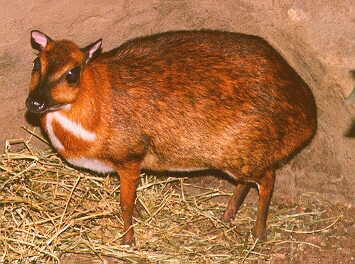
Philippine mouse-deer(Tragulus nigricans napu)
Phylum —chordata
Class — mammalia
Order — artiodactyla
Family — tragulidae
Genus – tragulus
Appearance
It has a black and brown coat with white stripes on the throat and chest. The head is generally darker in color than the rest of the body. Broad rufous or fulvous 'eyebrow' stripes extend from the anterior corners of the eyes to the base of ears. The bridge of the nose and forehead are dark brown, becoming increasingly infused with black towards the crown of the head.
On average, the Philippine mouse-deermeasures 40–50 cm from the head to the tail base and reaches an average of 18 cm tall at shoulder height.
The male of its species does not have any antlers like a true deer. They use their large, tusk-like canine teeth on the upper jaw for self-defense or territorial fights with other males.
Habitat
It lives on the landsendemic to Balabac and nearby smaller islands (Bugsuk and Ramos) southwest of Palawan in the Philippines.
Behavior
It is a solitary, nocturnal animal, but has on occasion been seen in pairs for short periods of time. During the day, it takes shelter in the dense primary and secondary forests and avoids movement. At sundown, it will wander into mangroves and more open areas to feed. They have also been spotted along the seashore.
Diet
The Philippine mouse-deer's main diet consists of leaves, flowers, and other vegetation in the dense forest undergrowth.
Reproduction
Philippine mouse-deeris thought to reach sexual maturity at 5 months of age. The mouse-deer has been estimated to live about 14 years and usually produces one offspring per litter. Two offspring can occur, but is extremely rare. The gestation time ranges from 140 to 177 days.
In captivity
In captivity, the Philippine mouse-deer is not quite whimsical and can be kept both in a closed enclosure and in the open air. If the temperature is below zero, they need to be taken to closed rooms. It is better to build a closed-type aviary (warm aviary), which has access to an open space surrounded by a fence. The exit should be covered with curtains to keep warm. In such conditions, the deer will go out into the fresh air even in winter. In the winter part of the enclosure (house) should be covered with a straw which the deer use as a bed for sleeping. The house must be regularly cleaned and the straw changed.
Philippine mouse-deer must always have free access to fresh drinking water.
 Russian
Russian
 English
English
























